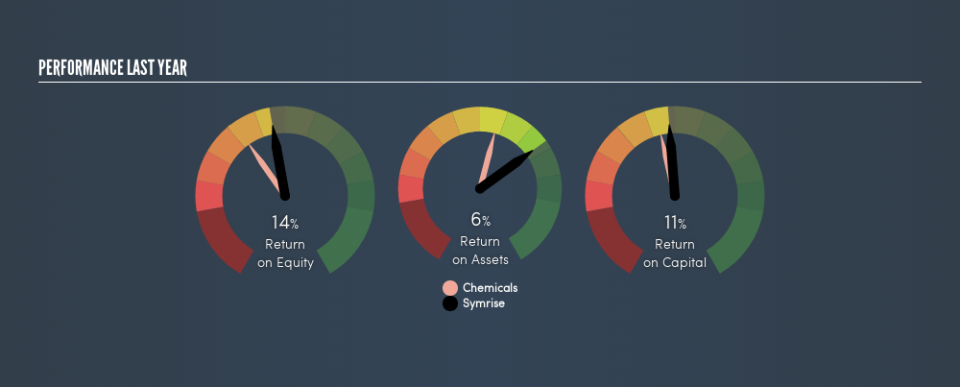Symrise AG (ETR:SY1) Is Employing Capital Very Effectively

Today we are going to look at Symrise AG (ETR:SY1) to see whether it might be an attractive investment prospect. To be precise, we'll consider its Return On Capital Employed (ROCE), as that will inform our view of the quality of the business.
Firstly, we'll go over how we calculate ROCE. Then we'll compare its ROCE to similar companies. Then we'll determine how its current liabilities are affecting its ROCE.
What is Return On Capital Employed (ROCE)?
ROCE measures the amount of pre-tax profits a company can generate from the capital employed in its business. In general, businesses with a higher ROCE are usually better quality. Overall, it is a valuable metric that has its flaws. Author Edwin Whiting says to be careful when comparing the ROCE of different businesses, since 'No two businesses are exactly alike.'
So, How Do We Calculate ROCE?
Analysts use this formula to calculate return on capital employed:
Return on Capital Employed = Earnings Before Interest and Tax (EBIT) ÷ (Total Assets - Current Liabilities)
Or for Symrise:
0.11 = €424m ÷ (€4.9b - €1.2b) (Based on the trailing twelve months to December 2018.)
Therefore, Symrise has an ROCE of 11%.
See our latest analysis for Symrise
Is Symrise's ROCE Good?
ROCE can be useful when making comparisons, such as between similar companies. Symrise's ROCE appears to be substantially greater than the 8.2% average in the Chemicals industry. I think that's good to see, since it implies the company is better than other companies at making the most of its capital. Regardless of where Symrise sits next to its industry, its ROCE in absolute terms appears satisfactory, and this company could be worth a closer look.
You can see in the image below how Symrise's ROCE compares to its industry. Click to see more on past growth.
Remember that this metric is backwards looking - it shows what has happened in the past, and does not accurately predict the future. ROCE can be deceptive for cyclical businesses, as returns can look incredible in boom times, and terribly low in downturns. ROCE is only a point-in-time measure. What happens in the future is pretty important for investors, so we have prepared a free report on analyst forecasts for Symrise.
What Are Current Liabilities, And How Do They Affect Symrise's ROCE?
Current liabilities include invoices, such as supplier payments, short-term debt, or a tax bill, that need to be paid within 12 months. Due to the way the ROCE equation works, having large bills due in the near term can make it look as though a company has less capital employed, and thus a higher ROCE than usual. To counteract this, we check if a company has high current liabilities, relative to its total assets.
Symrise has total liabilities of €1.2b and total assets of €4.9b. Therefore its current liabilities are equivalent to approximately 25% of its total assets. Current liabilities are minimal, limiting the impact on ROCE.
What We Can Learn From Symrise's ROCE
This is good to see, and with a sound ROCE, Symrise could be worth a closer look. There might be better investments than Symrise out there, but you will have to work hard to find them . These promising businesses with rapidly growing earnings might be right up your alley.
If you like to buy stocks alongside management, then you might just love this free list of companies. (Hint: insiders have been buying them).
We aim to bring you long-term focused research analysis driven by fundamental data. Note that our analysis may not factor in the latest price-sensitive company announcements or qualitative material.
If you spot an error that warrants correction, please contact the editor at editorial-team@simplywallst.com. This article by Simply Wall St is general in nature. It does not constitute a recommendation to buy or sell any stock, and does not take account of your objectives, or your financial situation. Simply Wall St has no position in the stocks mentioned. Thank you for reading.

